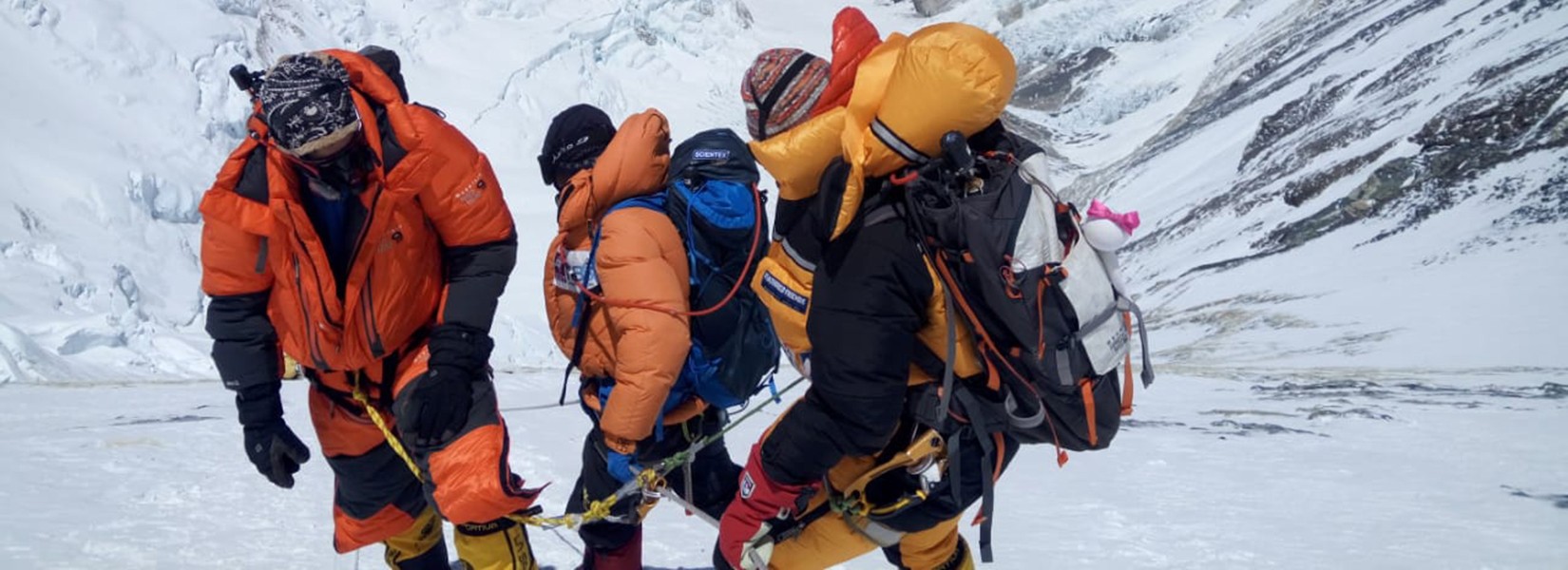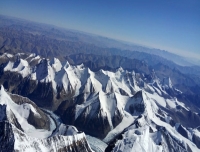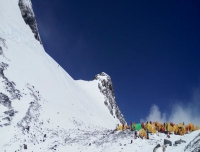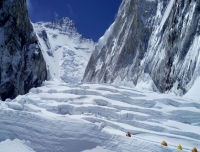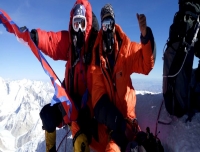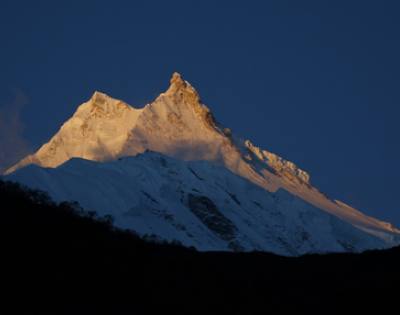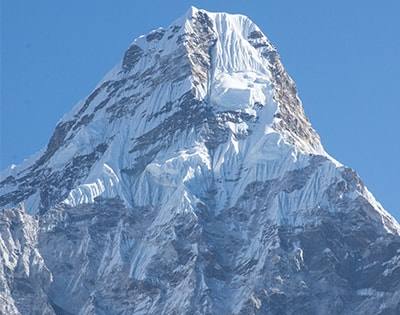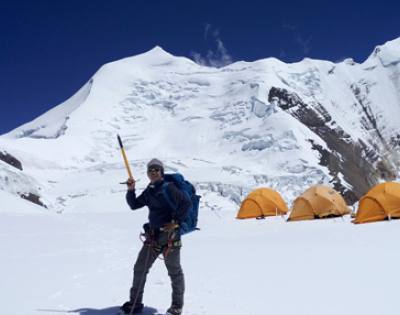- Read Reviews onTripadvisor
- Phone & WhatsApp Support+977 9851112535 (Chandra Shor)
Mount Everest Expedition [8,848 meters/ 29,029 ft] | 65 Days
Fact Information
- Duration
- 65 Days
- Destination
- Nepal
- Difficulty
- Extremely difficult
- Accommodation
- Hotel, Lodge &Tent
- Activity
- Expedition
- Transportation
- Tourist Bus, Car & Airplane
- Meals
- BLD (Breakfast, Lunch and Dinner)
- Max Person
- 15 in a group
- Min Person
- 1
- Maximum altitude
- 8,848m, (29,029 ft)
- Best season
- Mid March to the end of May
About Trip
For those with a thirst for adventure and the courage to pursue their dreams, climbing Mount Everest represents the ultimate achievement, with the summit at an altitude of 8,848 meters (29,029ft) offering boundless happiness and satisfaction.
Mount Everest, known as "Sagarmatha" in Nepali and "Chomolungma" in Tibetan, is the highest mountain on Earth, standing at an altitude of 8,848.86 meters (29,031.7 ft) above sea level. It is located in the Mahalangur Himalaya range of the Himalayas in the Nepali and Tibet border, with a latitude of 27.9881° N and a longitude of 86.9253° E. Climbing Mount Everest is a difficult and challenging endeavor that requires a high level of mountaineering experience, physical and mental preparation, proper equipment, training, and a responsible team. Despite the challenges, reaching the summit of Mount Everest is a remarkable achievement that many people dream of but few ever achieve.
The history of climbing Mount Everest dates back to May 29, 1953, when Tenzing Norgay and Sir Edmund Hillary made the first successful ascent from the Nepali side via the South Col standard route. Since then, Everest has become famous all over the world and draws a large number of mountaineering enthusiasts, adventure-seekers, and record-breakers every year. However, making a successful attempt requires careful planning and preparation, as well as a significant investment of time and money.
To achieve a successful ascent, most climbers trek to Everest Base Camp, which is located at an altitude of 5,380 meters (17,600 feet) above sea level. The journey from Kathmandu to base camp takes about 7-10 days and involves trekking through Sagarmatha National Park, a UNESCO World Heritage site, with scenic villages, monasteries, and cultivated farmlands along the way. Once at base camp, climbers typically spend several weeks adjusting to the altitude and preparing for the ascent. This involves several trips up to higher altitudes to help the body adapt to the low oxygen levels.
If you're interested in climbing Mount Everest, you can join a commercial organizer team that offers reasonable expedition costs and quality service. However, it's important to remember that climbing Everest is an extremely challenging undertaking and should not be taken lightly. It requires a high level of physical and mental fitness, as well as a willingness to face unpredictable weather and terrain conditions. Nevertheless, if you have the dedication and perseverance to make it to the top, reaching the summit of Mount Everest will be a lifetime experience and a testament to your strength and courage.
Trip Highlights
Everest Expedition Campaign:
Join the International Everest Expedition campaign in 2023 and conquer the world's highest peak in the Himalayas to become one of the most adventurous mountaineers on the planet. Our team is not only professional but also honest and responsible, with strong, helpful, and experienced guides and high-altitude support climbing team, who have recently summited Everest. We use only high-quality supplementary gear, such as oxygen cylinders and mask regulators.
Our previous Everest Expedition had a 100% success rate, with three climbers reaching the summit in 2018. Climbing Mount Everest is one of the greatest mental, physical, and economic challenges in the world, but it also provides a wonderful feeling of pride and achievement.
To join the International Everest Expedition team in Nepal, you must have extensive mountaineering experience, including participation in expeditions at least 6,000 meters high, as well as experience in scaling difficult alpine mountain peaks, preferably between 7,000 and 8,000 meters in the Himalayas, and basic mountaineering skills. In the Everest expedition, climbers must be able to ascend and descend independently with support of fixed ropes and be proficient in using tools such as Jumar, ATC guide, and crampons on steep ice, rock, and snow slopes.
Our main objective is to ensure your safe, enjoyable, and successful climb, and to help you achieve your aspirations and dreams at an affordable price. Experience the greatest sense of personal achievement in your life by joining us on this incredible adventure!
We have a fixed departure date for the 2023 Everest expedition: March 25, 2023.
We will depart from Kathmandu on March 25, 2023, for the Everest base camp. However, if you are not available or prefer to trek solo or from a different starting point, we are flexible and can help you plan a customized climbing itinerary. Just share your ideas with us and we will assist you in creating the best climbing experience.
Our climbing journey will begin in the first week of April with a Puja ceremony to honor the goddess mother Sagarmatha at the Everest base camp, ensuring a safe and successful climb. The following day, our team of guides will provide training on essential skills, such as crossing vertical and horizontal ladders on the Khumbu Icefall, climbing ice slopes using crampons, ice axes, and jumars (ascender devices), and self-rappelling.
Next, we will proceed to Lobuche High Camp, located at an altitude of 5,200 meters (17,060 ft) for a summit push of Lobuche East, which stands at an altitude of 6,119 meters (20,075 ft). After summiting Lobuche East, we will return to Everest Base Camp for a few days of rest and acclimatization before heading to Camp 1, which is situated at 6,065 meters. We will spend at least one to two nights at Camp 1 before returning to Base Camp to rest and enjoy delicious meals.
After a few days of rest at Base Camp for our recovery, we will prepare for Camp 2, which is located at 6,400 meters above sea level. We will stay there for 1 to 2 nights before returning to Base Camp to rest. Before making the final push to the summit, we will touch Camp 3, which is located at 7,100 meters above sea level, and spend one night there. After completing our climbing rotation, we will trek down to Dingboche or Pangboche to relax for some time. Then we will continue our trip to Base Camp for the final summit push. After checking the weather window, we will climb to Camp 2, where we will take a one-day rest. Afterward, we will climb to Camp 3 and Camp 4 at the South Col, which is located at an altitude of 7,920 meters above sea level, for the final summit push to reach the peak of 8,848.86 meters.
After reaching the summit, we will return to Camp 4, then to Camp 2, Base Camp, and either fly back to Kathmandu or trek down to Lukla and fly back to Kathmandu. The entire climb typically takes around two months for a successful ascent of Mount Everest.
Outlined Itinerary
Day 01: Arrival in TIA Kathmandu Airport 1,340 m, (4,429 ft), transfer to hotel.
Day 02: Special climbing preparation day, permits, and gears, welcome dinner.
Day 03: Drive to Ramechhap airport 135km, to fly Lukla and trek start to Phakding (2,610 m).
Day 04: Trek from Phakding to Namche Bazaar 3,440 m, (11,286 ft), 5hrs.
Day 05: Hike to Everest view Hotel 3,870 m, (12,697 ft), for the panoramic view.
Day 06: Trek from Namche to Tengbuche Monastery 3,860 m, (12,664 ft), 5hrs.
Day 07: Trek from Tengboche to Dingbuche village 4,410 m, (14,468 ft), 5hrs.
Day 08: Hike to Nangkartshang viewpoint 5,083 m, (16,676 ft), 3hrs.
Day 09: Trek from Dingboche to Lobuche 4,910 m, (16,108 ft), 5hrs.
Day 10: Trek Lobuche to Gorak shep 5,171 m, 3hrs, afternoon hike to Kalapathar 5,550 m.
Day 11: Trek to EBC 5,364 m, (17,598 ft), stay in tented.
Day 11 to 55 day fully climbing time.
Detailed Itinerary
Day 01: Arrival in Kathmandu Airport 1,350 meters (4,429 ft), transfers to hotel.
Representatives from Himalayan Diamond Adventures will greet you upon your arrival at Tribhuvan International Airport in Kathmandu. You will be welcomed with a fresh flower garland, a traditional Nepali greeting, and then escorted to the hotel for bed and breakfast service. The drive from the airport to the hotel takes approximately 15 to 20 minutes, if there is no traffic jam on our way. After checking into the hotel, we will have a short refreshment meeting at the hotel. In the evening, the company will host a welcome dinner at a traditional Nepali restaurant, complete with a cultural dance performance, to celebrate the start of your trip. During the dinner, your guide will provide a brief overview of the schedule for the following day.
Accommodation: 3 to 5 Stars standard of hotel.
Transportation: Tourist bus or car.
Meals: Welcome D, B, and drinks.
Day 02: Special climbing preparation day, such as permits, gears, and equipment.
This morning, we will have a meeting where our group leader will brief us about the upcoming expedition. After the meeting, our group leader and a company representative will visit the Nepal Tourism Board for an expedition briefing and to obtain expedition permits. Meanwhile, our guide and the rest of the climbers will need to confirm their necessary climbing gear and equipment for the trekking and expedition. If it is found that someone does not have the proper equipment and gear, the guide will help them collect or hire it from the trekking shops in Thamel.
Maximum elevation: 1,350 meters, (4,429 ft).
Accommodation: 5 Stars hotel.
Meals: Breakfast.
Day 03: Fly to Lukla 2,840m (9,317 ft), trek begins to Phakding 2,610m (8,563 ft), 2. 3hrs.
Tomorrow morning, we will depart from Ramechhap airport with an early flight, so we will have to leave from the hotel in Kathmandu very early. The drive to Ramechhap airport will take approximately 5 to 6 hours, covering a distance of 135 kilometers.From Ramechhap airport, we will take a short but thrilling flight to Lukla Hillary airport, known for its high altitude of 2,860 meters and its short and narrow runway. After a short break in Lukla for final trip preparations, we will embark on our journey to Phakding. The trek will take us along a straightforward path, passing through beautiful Sherpa lands and religious sites with breathtaking landscapes. After 2 and a half to 4 hours of comfortable trekking, covering a distance of 7.5 km (4.6 miles), we will reach Phakding at an altitude of 2,610m (8,563 ft).
Maximum Elevation: 2,860m (9,383 ft).
Trekking hours: 2.5hrs, 200m descent, 50m ascent.
Accommodation: Lodge.
Meals: L, Dr, B and hot drinks.
Day 04: Trek to Namche Bazar 3,440 meters (11,286 ft), 5-6 hours.
We will continue our mountain journey, following the Dudh Koshi River. The trail will lead us to Sagarmatha National Park through the Dudh Koshi River valley, passing many beautiful villages, restaurants, and guesthouses, as well as cultivated farm lands, waterfalls, and well-constructed suspension bridges over the Dudh Koshi River. As we trek through the village of Banker, we will have a stunning view of Kusum Kanguru (6,369 m) and Thamserku (6,623 meters). After 2 to 3 hours of slightly uphill trekking, we will reach Sagarmatha National Park, where we will need to present our permits and enter it. Today, we should have an early hot lunch before leaving the last settlement of Jorsalle. After
leaving Jorsalle, there are no places to eat hot meals until we reach Namche Bazar. From Jorsalle, our trail continues straight ahead to the confluence of the Dudh Koshi and Bhote Koshi rivers, following the
Dudh Koshi River. Before starting the tiring uphill trail, we will cross the famous Hillary Bridge, the highest bridge over the Dudh Koshi River. We will trek for about 5 to 7 hours, covering a distance of 12.5 kilometers, with stunning landscapes throughout the journey from Phakding.
Elevation: 3,440 meters, (11,286 ft).
Trekking hours: 5hrs, 10,00m ascent, 100m descent.
Accommodation: Lodge with private bathrooms.
Meals: B, L, D and hot drinks.
Day 05: Hike to Everest view Hotel 3,870m (12,697 ft), for panorama view.
Today is a rest day for us, it's very important to take a rest day after rapidly ascending a mountain. Even though we don't take a rest, we will hike to the Everest View Point (3,867m or 12,687ft) for the best panoramic view of Mount Everest and other beautiful mountain views. If we have time, we will visit Khumjung village, the Yeti Scalp Monastery, and the Mountain Museum in Namche Bazaar."
Overnight stay at a lodge in Namche Bazar.
Maximum elevation: 3,870m (12,697 ft).
Visit: Khumjung village and Hillary school.
Accommodation: Lodge.
Meals: B, L, D and hot drinks.
Day 06: Trek to Tengboche Monastery 3,860 meters (12,664 ft), 5hrs.
Today, we're on day three of our mountain journey to Tengboche Monastery (altitude of 3,860 meters). The hike will take about 5-6 hours, covering 9.2 km from Namche, surrounded by stunning mountain views. The trail starts with a difficult path above Namche Bazar, but quickly becomes easier with breathtaking views of Mount Everest, Lhotse, Thamserku, and Amadablam. After a relaxing hike along the Kyangjuma valley and a break for lunch at Phunge Thanga, the trail becomes challenging from the Armi checkpoint area until Tengboche Monastery. The hike is difficult, but more enjoyable in April to May when rhododendron flowers bloom. This evening, we will visit the significant Tengboche Monastery.
Maximum Elevation: 3,860 meters (12,664 ft).
Trekking hours: 4 to 5hrs, 350m descent, 750m ascent.
Accommodation: Lodge.
Meals: B, L, D and hot drinks.
Day 07: Trek to Dingboche village 4,410 meters, (14,468 ft), 5hrs.
Today we will trek to Dengboche village, the last major settlement before EBC, in a 6-7 hour hike covering 6.5 miles (10.5 km). We will start with a slight descent through a forest of silver pines, birches, and rhododendrons with magnificent views of Everest, Lhotse, and Amadablam and cross the Imja Tse stream on a high suspension bridge. After crossing the bridge over the Imja river, the trail ascends slightly to Pangboche village with a breathtaking view of Mount Amadablam. We will stop for lunch at Somare. After lunch, we will continue on an off-the-beaten trail with a gradual ascent to Dingboche village, our final destination with stunning views of Lhotse and Lhotse Shar.
Maximum Elevation: 4,410 meters, (14,468 ft).
Trekking hours: 4 to 5 hours, 70 descent, 580m ascent.
Accommodation: Lodge included private bathrooms.
Meals: B, L, D and hot drinks.
Day 08: Acclimatization Day, hike to Nangkartshang viewpoint 5,083 meters (16,676 ft), 3 hours.
Today is our designated rest day. It's crucial to take a break after quickly ascending in the mountains. If we choose not to rest, we will climb Nangkartshang Hill for 360-degree views of the surrounding peaks, which is also good for acclimatization. From the top, we will see breathtaking views of Island Peak, the most popular peak in the region, and Mount Makalu, located in the distance. After admiring the views, we will return to T-House for a hot lunch and rest.
Maximum Elevation: 5,083 meters (16,676 ft).
Hiking hours: 4 hours, 400m ascent.
Accommodation: Lodge includes private bathrooms
Meals: Breakfast, Lunch, Dinner with hot drinks.
Day 09: Trek to Labuche 4,910 meters (16,108 ft), 5 hours.
Today, on our two-day stay in Dingboche, we will trek to Lobuche, which is located at an altitude of 4,910 meters. The trek will pass through wide Yak and horse grazing lands, yak herders' huts above Pheriche village, and a small Khumbu Glacier's milk river. Before starting the strenuous uphill trail, we will stop at Thukla Sherpa village to refill our energy. We will also see chortens built in memory of those who lost their lives in attempts to climb Mount Everest and Lhotse peak. Today's hike will take 5-6 hours and cover a distance of 10.7 km, ending in Lobuche where we will check into our rooms for some rest. Afterwards, we will hike to the Khumbu glacier viewpoint.
Maximum Elevation: 4,910 meters (16,108 ft).
Trekking hours: 4 to 5 hours, 500m ascent.
Accommodation: Lodge.
Meals: B, L, D with hot drinks.
Day 10: Trek to Gorak shep the last settlement 5,171 meters (16,965 ft), 6hrs.
Today we will trek from Lobuche to Gorak shep, following the Khumbu glacier edge and passing through stones and moraines. The trail takes a slightly uphill direction, but offers exhilarating views along the way. After a slow hike of 3 to 4 hours, covering a distance of 2.8 miles / 4.5 kilometers, we will reach Gorak shep village, the last permanent settlement on the EBC trail. After a hot meal in Gorak shep, we will hike to Kalapathar, 5550 meters, for a beautiful sunset view of the mighty Mount Everest. Is it correct sentences? Can you correct me?
Maximum Elevation: 5,550 meters (18,208 ft).
Trekking Hours: 6 to 7 hours, 250m ascent.
Accommodation: Lodge.
Meals: B, L, D with hot drinks.
Day 11: Everest base camp 5,364m (17,598 ft), where we stay 2 months.
We are very excited to be reaching Everest Base Camp, which is located at an altitude of 5,400 meters (17,716 feet). After completing our regular morning activities, we will begin trekking towards the base camp. The route will take us through a variety of terrain, including stones, gravel, and glaciers, and we will have magnificent views of the mountains throughout. During the snowfall season, rocks can fall along the way, so we need to be careful. After walking along the edge of the Khumbu glacier for about two hours, we will arrive at Everest Base Camp, where we will meet our climbing staff and friends. During peak climbing season, we may encounter many other climbers, suppliers (using yaks to transport equipment), and trekkers on our way to the base camp. The base camp is a busy place, full of sprawling climbers' tents, and it is a great day for those who dream of adventure. After relaxing in our tents for a few minutes, our group leader will brief us on the expedition, base camp rules, training, and climbing.
Day 15 – 55: Climbing period. Staying at our “Home away from Home.
We will start our climbing journey by offering a Puja ceremony to the goddess mother Sagarmatha at the base camp for a safe and successful climb. The next day, our team of guides will train us on various skills, such as crossing vertical and horizontal ladders on the Khumbu Icefall, climbing ice slopes using crampons, ice axes, and jumars (ascender devices), and self-rappelling. We will then proceed to Lobuche High Camp, which is located at an altitude of 5,200 meters above sea level, for a summit push of Lobuche East, which stands at an altitude of 6,119 meters. Afterward, we will return to Everest Base Camp and rest there for a few days before heading to Camp 1, which is located at 6,065 meters above sea level. We will stay there for a minimum of one night to two nights before returning to Base Camp to rest and enjoy delicious meals.
After a few days of rest at Base Camp for our recovery, we will prepare for Camp 2, which is located at 6,400 meters above sea level. We will stay there for 1 to 2 nights before returning to Base Camp to rest. Before making the final push to the summit, we will touch Camp 3, which is located at 7,100 meters above sea level, and spend one night there. After completing our climbing rotation, we will trek down to Dingboche or Pangboche to relax for some time. Then we will continue our trip to Base Camp for the final summit push. After checking the weather window, we will climb to Camp 2, where we will take a one-day rest. Afterward, we will climb to Camp 3 and Camp 4 at the South Col, which is located at an altitude of 7,920 meters above sea level, for the final summit push to reach the peak of 8,848.86 meters.
After reaching the summit, we will return to Camp 4, then to Camp 2, Base Camp, and either fly back to Kathmandu or trek down to Lukla and fly back to Kathmandu. The entire climb typically takes around two months for a successful ascent of Mount Everest.
Cost Details
What's included
Services and Equipment Included in $45,000.00:
Transportation Services:
✓ Airport pickup and drop-off by a private vehicle.
✓ Private Car or Bus transportation from Kathmandu to Ramechhap airport and back
✓ Ramechhap/Lukla/ Ramechhap flight fare and 45 Kg Luggage cargo.
✓ Luggage transport as per the itinerary is included
Accommodations:
✓ 4 nights' stay at Hotel Moonlight in Kathmandu, inclusive bed and breakfast service
✓ T-house (lodge) accommodations during the trek, that are clean and comfortable
Food and Beverages:
✓ Three meals a day (breakfast, lunch, and dinner, along with dessert) and hot drinks (tea and coffee) are included during the trek.
✓ The menu is as per the client's choice
Permits and Fees:
✓ Peak royalty, Sagarmatha National Park fees, Khumbu Pasang Lhamu Community Fee
✓ All necessary trekking and climbing permits
✓ Khumbu Ice fall route opening charge and rope fixing charge
✓ Garbage management fees (human waste shipment transfer and garbage deposit)
✓ Necessary documentation and governmental official paperwork and taxes/VATs
✓ Government liaison officer with insurance, daily allowance, equipment allowance, and flight fares
Guides and Support Staff:
✓ English-speaking, well-trained, skilled, and experienced high-altitude porters and 1 guide each member above camp -3 with daily salary, lodging, food, transportation, and accommodation
✓ Base camp manager with equipment, daily salary, lodging, food, transportation, and accommodation
✓ Base camp chef with equipment, daily salary, lodging, food, transportation, and accommodation
✓ Base camp staff and kitchen staff with equipment, daily salary, lodging, food, transportation, and accommodation
Equipment and Supplies:
✓ Oxygen (4 litres summit or 4litres Russian cylinder per member 6 bottles, plus 4-cylinder bottles for high altitude porters/guide)
✓ Mask and regulator (1 set per member, plus spares for the team)
✓ We will provide porters to transport members' belongings to and from Base Camp and Lukla.
Our Base Camp service:
✓ Each member will be provided with a Nepalese-made box tent, mattress, and pillow at Everest Base Camp.
✓ We provide group services for Nepali and foreign tents, mattresses, a dining hall, a kitchen tent, a storage tent, a communication tent, a toilet tent, and a shower tent.
✓ We provide freshly cooked meals (breakfast, lunch, and dinner) including Continental, Nepali, Indian, and Chinese cuisine, along with hot drinks such as tea and coffee.
✓ Communication: Satellite phone and Radio set
Our Higher Camp services:
✓ We provide high-altitude, medical, and helicopter rescue insurance for climbing Sherpas, cooks, and other Nepalese staff involved in the expedition.
✓ We provide higher camp services, including necessary equipment, high-altitude tents, a communication tent, solar light a toilet tent, a shower tent, and high-altitude food.
✓ We provide cooking gas, white gas, cooking pots, high-altitude tents, and climbing gear (such as static ropes, guide ropes, snow bars, ice screws, carabiners, etc.)
✓ Communication: Satellite phone and Radio set
Our Crucial services:
✓We have a team of strong and helpful porters with proper equipment, as well as yaks or helicopter transportation as alternative options for transporting only expedition materials.
✓ Medical supplies (first aid kit available)
✓ We have a Nepalese staff insurance policy that covers rescue evacuation, medical treatment, hospitalization, and accidents.
✓We provide emergency helicopter rescue insurance for Nepalese staff.
✓ Government taxes and official expenses
✓ Emergency contact and emergency plan
✓ Welcome and farewell dinner at a tourist standard restaurant
What's not included
❖ Personal insurance
❖ Personal trekking equipment and gears.
❖ Nepal entry visa fee.
❖ International airfare bill.
❖ Extra night accommodation in Kathmandu because of early arrival, late departure, early return from mountain (due to any reason) than the
❖ Meals while you stay in Kathmandu Hotel Lunch and Dinner.
❖ Your travel insurance policy should be covered rescue evacuation, medical treatment and accidental.
❖ Any entry fee for the temple or monastery.
❖ Donations or charity.
❖ Your personal expenses like; Hot shower, Laundry, Battery charging, telephone, WIFI, and shopping, etc.
❖ Alcoholic and non-alcoholic alcoholic hot and cold drinks.
❖ Tips for the guide, porter, and driver (tipping is expected
Map
![Mount Everest Expedition [8,848 meters/ 29,029 ft] Map](https://www.himalayandiamond.com/uploads/package/map/everest_summit_map.jpg)
Client Review
Useful Info
What Essential Documents Do I Need To Bring With Me On Tour?
When going on a tour, it's important to bring essential documents to ensure a smooth and hassle-free trip. Here are some documents that we highly recommend you bring with you.
Passport: If you're traveling to a foreign country, you'll need a valid passport. Make sure to check the expiration date and renew it if necessary.
Visa: Depending on your destination, you may need a visa to enter the country. Check with the embassy or consulate of the country you're visiting to see if you need a visa.
Travel itinerary: It's always a good idea to have a printed copy of your travel itinerary, including flight and hotel reservations, tour bookings, and any other important travel plans.
Travel insurance: Consider purchasing travel insurance to protect yourself against unforeseen events, such as trip cancellations, medical emergencies, and lost or stolen luggage.
Health documents: If you're traveling to a country with specific health requirements, such as a yellow fever vaccination, make sure to bring the necessary health documents.
Driver's license: If you plan on driving while on tour, make sure to bring your driver's license.
Credit cards and cash: Bring enough cash and credit cards to cover your expenses while on tour.
Emergency contact information: Write down the contact information for someone you trust in case of an emergency. This could include a family member, friend, or employer.
It's always a good idea to make copies of all your important documents and keep them in a safe place in case the originals get lost or stolen. Additionally, you may want to consider using a travel document organizer to keep all your important documents organized and easily accessible.
If you are traveling to Nepal, then here are some essential documents you will need to have with you in order to ensure a smooth and hassle-free trip.
What Essential Documents Do I Need To Bring With Me For Everest Climbing Tripr?
❖ Valid passport with at least 6 months validity and at least 2 blank visa pages
❖ Travel insurance policy document
❖ Photocopies of your passport's personal information page
❖ One or more recent passport-sized photos with a white background (1.5 inch x 1.5 inch)
❖ Completed and signed Nepal visa application form
❖ Proof of accommodation in Nepal (such as a hotel reservation or address)
❖ Valid return flight or travel ticket
❖ Proof of sufficient financial means, such as recent bank statements
❖ Mastercard, Visa, and some cash in USD
❖ Proof of payment of the Nepal visa fee
❖ To obtain a visa for Nepal, your passport must be valid for at least 6 months from the travel date and you must present either a completed COVID-19 vaccination certificate with QR code or a valid PCR test negative result taken within 72 hours prior to boarding.
How to apply for an online tourist visa to Nepal?
Visit the official website of the Department of Immigration of Nepal at https://www.immigration.gov.np/page/tourist-visa
1. Fill out the online application form with your personal information, including your name, date of birth, nationality, passport number, and intended travel dates.
2. Upload a recent passport-size photograph in JPEG or PNG format.
3. Pay the visa fee online using a credit card or debit card. The cost of the visa depends on the length of your stay in Nepal, but it typically ranges from $30 to $125.
4. Once you have submitted your application and payment, you will receive a confirmation email with a receipt and an application ID.
5. After your application has been processed, you will receive another email with a link to download your visa. You should print out the visa and carry it with you when you travel to Nepal. It's important to note that the online tourist visa is valid for multiple entries and is valid for 15, 30, or 90 days, depending on your length of stay. Also, be sure to apply for your visa well in advance of your travel date to allow time for processing.
What Type Of Insurance Should I Get?
It is essential for foreign travelers to secure insurance coverage while trekking or climbing in Nepal. Although trekking in Nepal is generally safe, travel insurance is compulsory for mountaineering activities in Nepal. The trip can pose physical challenges and hazards, particularly at high altitudes where altitude sickness is prevalent among trekkers and climbers, especially those who have not acclimatized properly. Physical injuries can also occur on mountain trails or during climbing activities, and in emergency situations, foreign trekkers or climbers may need to be rescued by helicopter and transported to hospitals in Kathmandu, which can be costly if the traveler does not have insurance coverage.
We strongly recommend purchasing a travel insurance package that covers high altitudes up to 65,00 meters, potential medical issues, natural disasters, personal accidents, emergency helicopter evacuation, loss or damage of personal belongings, and trip cancellations. The minimum recommended coverage amount is USD 100,000. There are many insurance companies that offer travel insurance services online. You should compare plans to find the one that best meets your needs.
What Are Some Popular And Highly Rated Travel Insurance Companies?
If you are in search of popular and highly-rated travel insurance companies, then we can recommend some based on positive feedback we have received from our previous travelers. It is here. [Company 1], [Company 2], [Company 3]............................
For Travelers from USA and CANADA........................
Online Global Health Insurance
Travelex
Insure My Trip.com (Online Insurance Aggregator)
Mondial Assistance
Access America
HCC Medical Insurance Services
Good Neighbor Insurance (International Health)
International Health
Insuremytrip dot com
MultiNational Underwriters
TIC Travel Insurance Coordinators Ltd
Travel Assist
TraveLite
For Travelers from England...................................
Specialty Group (UK) Limited
FirstAssist Services Limited
Harrison Beaumont
Buy cheap travel insurance
For Travellers from EUROPE and SLOVENIA...........................
Assistance CORIS
For Travellers from AUSTRALIA and NEW ZEALAND
Cover More Travel Insurance
CGU Insurance Limited
For Travellers from SOUTH AFRICA........................................
Travel insurance Consultants Pty. Ltd.
Weather Conditions & Temperature in Nepal
As Nepal's topography is divided into three geographical regions - Terai, Hills, and Mountains - each region experiences different temperatures during different seasons. Below is a tabular illustration of temperature changes throughout the different seasons in Nepal, which will allow you to better understand the changing weather conditions.
Seasons Minimum temperature (approx) Maximum temperature (approx) Weather Condition
Spring 4°C/ 39°F (Mountain) 20°C/ 68°F (Mountain) Moderate with occasional rain
Summer 12°C/ 53°F (Mountain) 25°C/ 77°F (Mountain) Extreme high with heavy rain
Autumn 3°C/ 37°F (Mountain) 18°C/ 64°F (Mountain) Moderate
Winter 10°C/ 50°F (Terai) -4°C/ 24°F (Mt.) 20°C/ 68°F (Terai) to 12°C/ 53°F (Mountain) Extreme low
What Is The Best Time To Trek In Nepal?
After a thorough analysis of all the seasons, it has been suggested that autumn is the best time of the year to trek in Nepal. The mild temperatures from September to November make the trekking experience more enjoyable. During this time of the year, trekking routes throughout the country are jam-packed with travelers from all around the world.
However, as mid-December is generally the holiday season in most countries, including the United States, there is a spike in the number of international tourists during early winter as well. Interestingly, to make the holiday season even more special, travel companies offer some of the best holiday destination packages during this time. So, be sure to take advantage of the best travel opportunities with the assistance of Himalayan Diamond Adventure.
Nonetheless, if you cannot make it in autumn, spring also allows for favorable conditions for trekking in Nepal. The warmer days and nights, lush plants and vegetation, and clear trekking trails during spring make the trek worthwhile. However, the downside is occasional rain and slightly higher temperatures in the lower elevations. All in all, after autumn, spring is the second-best time to trek in Nepal.
Best time to trek in Nepal:
Thousands of tourists visit Nepal every year to enjoy the picturesque nature and trek through the adventurous and diverse terrain. However, the best times to trek in Nepal are autumn (September to November) and spring (March to May). During these seasons, travelers are blessed with moderate temperatures and enjoyable weather conditions throughout the country.
As calm as it may seem, the challenging terrains of the Himalayas in Nepal can present trekkers with gruesome scenarios during harsh weather conditions. To avoid any unforeseen situations and to enjoy nature at its best, most trekkers prefer autumn for backpacking. However, it may not be the best time of the year to trek in Nepal for everyone. Some may prefer off-season trekking to avoid the crowds. Therefore, exploring the various seasons can help you choose a favorable time for trekking in Nepal based on your preferences.
Trekking Seasons in Nepal
Throughout the year, the landscape of Nepal experiences four seasons, each with its own uniqueness that brings significant changes to the natural environment. Below are some detailed insights into the four seasons in Nepal.
1. Spring Season (March-May)
Spring in Nepal lasts from March to May and is one of the preferred seasons for trekking throughout the country. During this time, the climate is moderate, with slightly higher temperatures reaching up to about 32°C (89°F) in the lower elevation regions and around 20°C (68°F) at higher altitudes. The sky is usually clear with mild days and occasional rain.
Spring brings a rejuvenation of nature. Flowers begin to blossom, trees become lusher with newly sprung leaves, and spring vegetation sprouts again. Likewise, the flora and fauna of the Himalayan terrain also resuscitate from the harsh winter. Overall, spring is considered a great time for trekking in Nepal due to the alluring freshness of nature.
2. Summer Season (June-August)
With the end of May, summer starts in Nepal and lasts from June to August, which is also the monsoon season in the country. During these months, the weather can be harsh, with scorching heat and heavy rain throughout the nation. The rising humidity and extreme hot weather conditions may restrict travelers from fully enjoying their trip.
Although the lower elevation regions experience harsh summers, the Himalayan terrains are not as brutal. In the mountain regions, temperatures can range from approximately 25°C to 12°C (77°F to 53°F). However, heavy rains can make trekking through rocky mountain terrain challenging, and the cloudy sky may obscure mountain views.
3. Autumn Season (September-November)
With the arrival of autumn from September to November, Nepal becomes a popular destination for trekking. During this season, the weather is usually pleasant with clear skies, moderate temperatures, and gentle sunshine throughout the day. However, early autumn may bring occasional light rainfall. As the season progresses into October and November, the monsoon season completely ends, and cooler weather conditions prevail.
Many people choose to trek to popular destinations such as Everest Base Camp, Annapurna Base Camp, and Poon Hill during this season. Additionally, autumn is festival season in Nepal, and visitors can witness major celebrations such as Dashain and Tihar, which provide an opportunity to experience Nepali culture and traditions. Many travel packages are available for the best treks in Nepal during this season, and our travel experts can help you plan your trip to align with the festival season.
4. Winter Season (December-February)
Winter, which lasts from December to February, is the harshest season for trekking in Nepal. As the temperature drops in December, nights become chilly, and temperatures can reach around 9°C (48°F) during the day and below 0°C (32°F) during the night in higher altitudes. During peak winter, many high passes and trekking routes in the mountains are covered with dense fog and snow, increasing the risk of unexpected accidents.
Because of the risks of unpleasant trekking conditions, most travelers avoid trekking in the Himalayan terrains during the winter season. Additionally, most expeditions and mountain climbing, including trekking in the Everest region, also come to a halt during the harsh winter. Overall, it may not be the best time to trek due to the challenges presented by the weather conditions.

